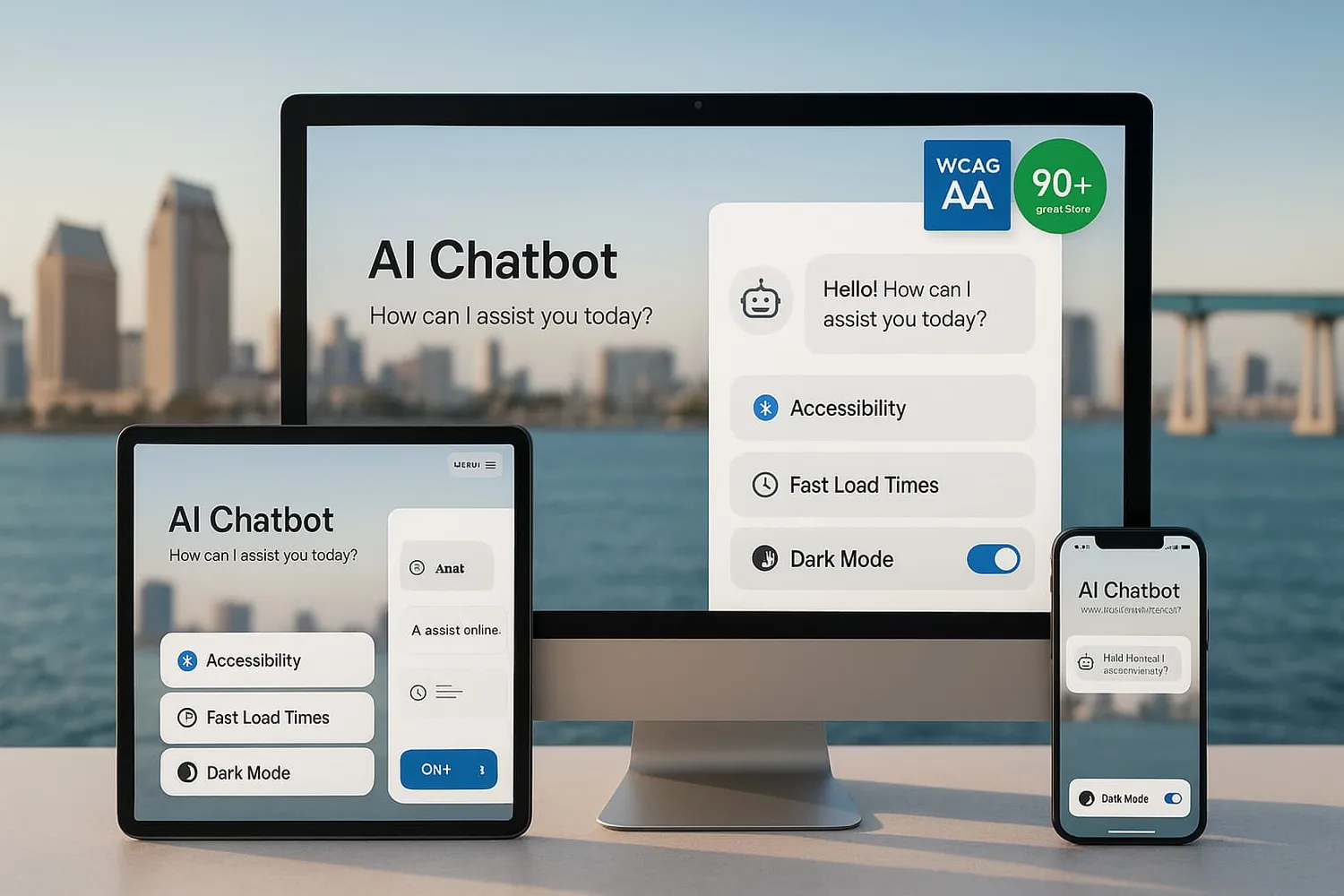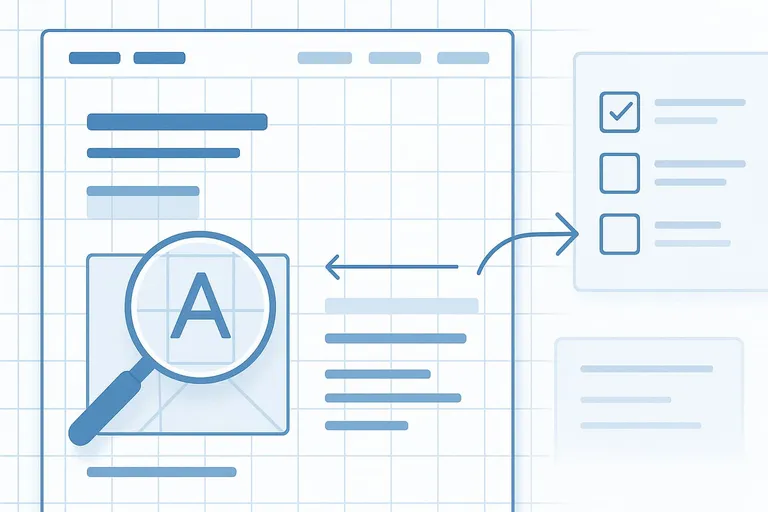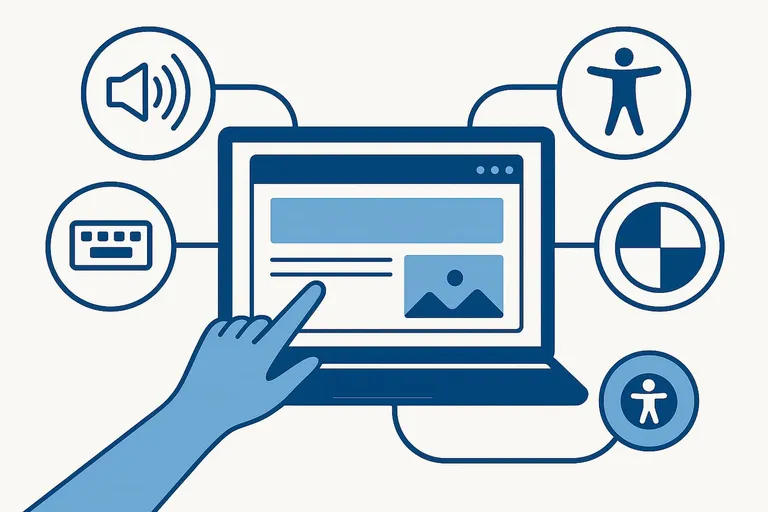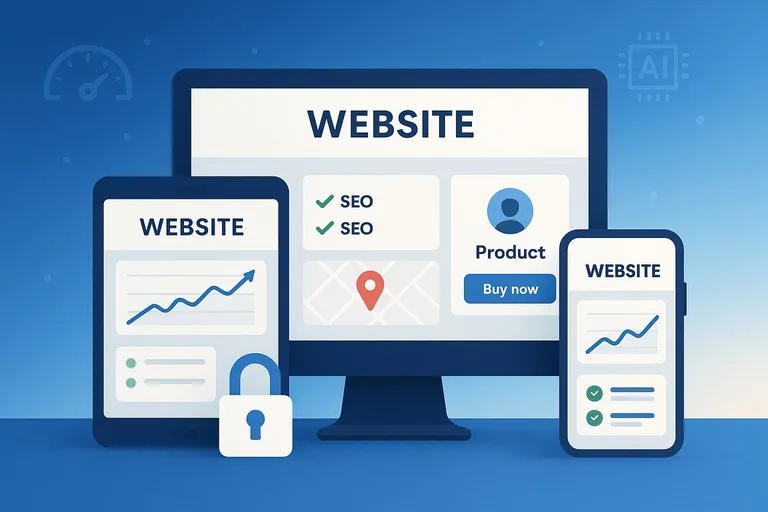Your website has exactly 50 milliseconds to make a first impression. In that split second, visitors decide whether you’re worth their time—or if your competitor’s site looks more trustworthy.
For San Diego businesses, those stakes are especially high. With 32 million tourists researching online, biotech companies competing globally, and local businesses from La Jolla to North Park vying for attention, your website is your most critical sales tool. The truth is, 94% of first impressions are design-related, and consumer expectations have fundamentally shifted.
This guide explores seven San Diego web design trends backed by 2024-2025 data and contextualized for local businesses. Whether you run a Pacific Beach restaurant, a Sorrento Valley startup, or a Hillcrest fitness studio, you’ll discover what actually drives results in America’s Finest City.
1. Mobile-First Performance: Speed Determines Success
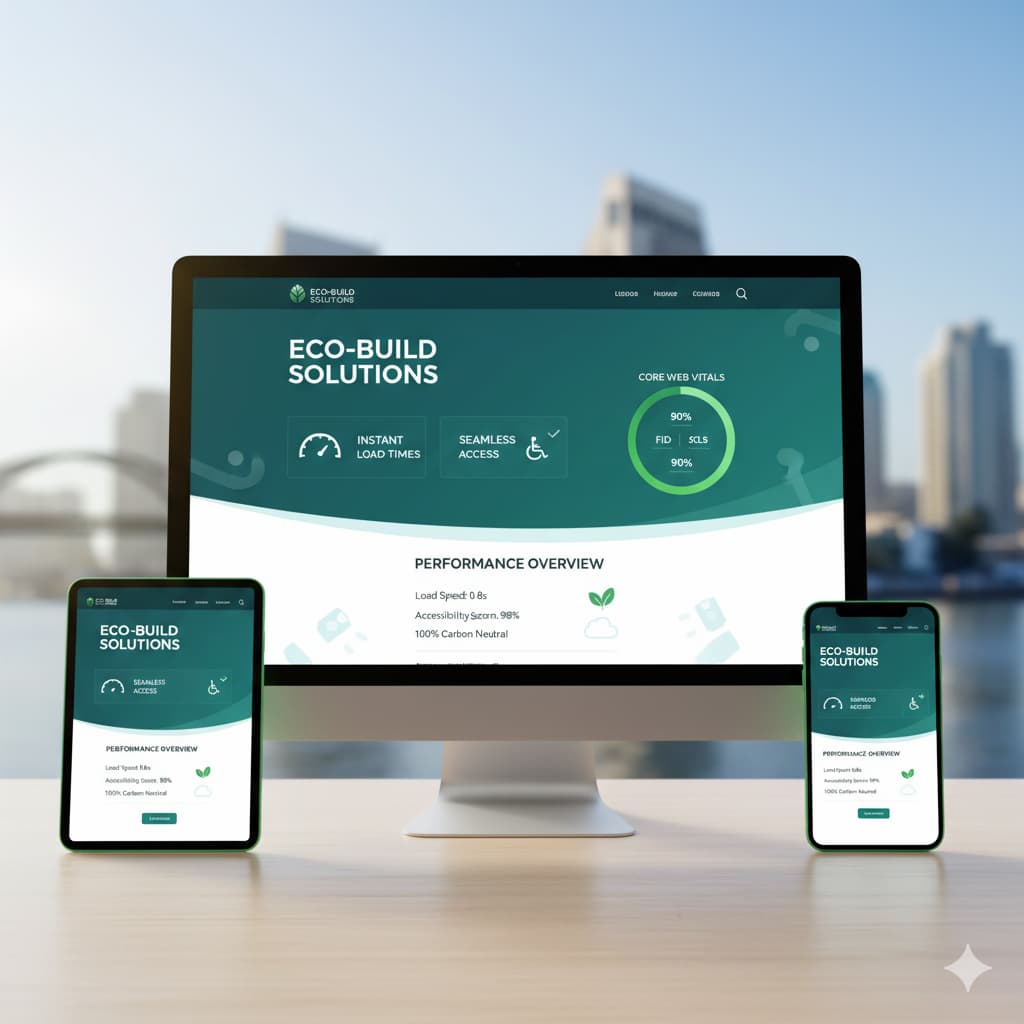
The reality: 47% of users expect websites to load in under 2 seconds, and 53% abandon mobile pages taking longer than 3 seconds. Yet only 44% of WordPress sites pass Core Web Vitals on mobile.
Financial impact: Every one-second delay reduces conversions by 7%. A page loading in 1 second has 3X higher conversion rates than one loading in 5 seconds.
Real San Diego Example: Local Restaurant
A Gaslamp Quarter restaurant reduced their site load time from 5.8 seconds to 1.9 seconds by compressing images and switching to managed hosting. Within 30 days, online reservations increased 42%, and their “view menu” clicks doubled.
Core Web Vitals: What Matters
Google’s performance metrics measure three factors:
- LCP (Loading): Target under 2.5 seconds
- INP (Interactivity): Target under 200 milliseconds
- CLS (Visual Stability): Target under 0.1
Currently, only 21.98% of websites meet all three metrics—creating opportunity for businesses willing to optimize.
Quick Wins for Better Performance
- Compress images below 500KB (most common performance killer)
- Implement a CDN like Cloudflare (improves speed by 72%, costs ~$20/month)
- Switch to managed WordPress hosting (improves pass rates by 71%)
- Use modern frameworks like Astro or static site generators for lightning-fast builds
Test using Google PageSpeed Insights on actual mobile devices—not everyone has 5G.
Complete guide: 9 Steps to Improve Core Web Vitals
2. Accessibility Compliance: Protection and Opportunity
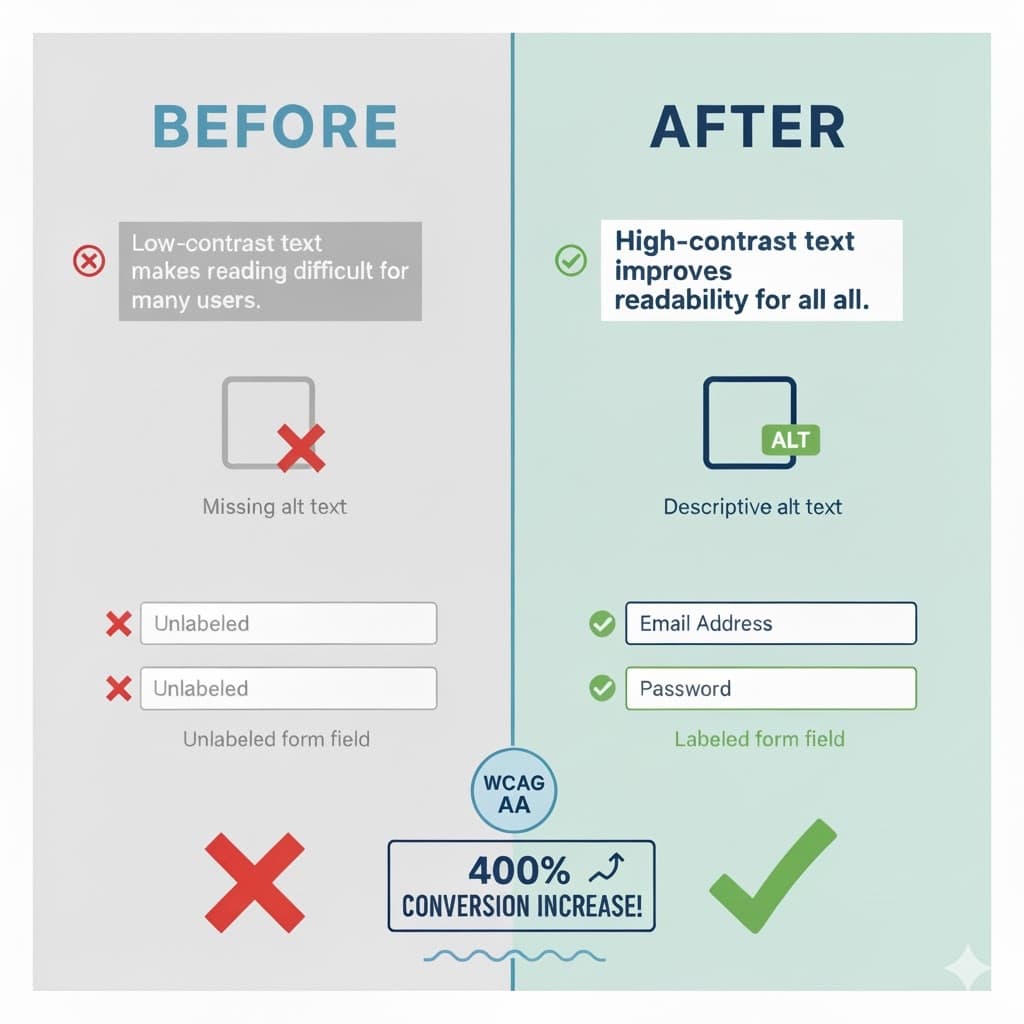
Here’s what you need to know: 94.8% of websites fail accessibility compliance. For San Diego businesses, this represents a $548 billion market you might be excluding—plus legal exposure.
California leads in ADA lawsuits: The state saw 3,252 website accessibility lawsuits in 2024—a 37% jump from 2023. California’s Unruh Civil Rights Act makes compliance especially important here.
The Business Case Beyond Legal Risk
Websites scoring 75+ on accessibility metrics show measurably higher revenue. Accessible design improvements can boost conversions up to 400%.
Here’s why: accessible websites offer better user experience for everyone. High-contrast text is easier for all users to read on bright San Diego beach days. Larger click targets help everyone on mobile devices.
The Six Most Common Issues (96% of All Errors)
- Low contrast text (79.1% of pages)
- Missing alt text for images (55.5%)
- Missing form labels (48.2%)
- Empty links (45.4%)
- Empty buttons (29.6%)
- Missing document language declarations (15.8%)
Getting Started
Begin with free tools like WAVE to identify these issues. Then prioritize high-impact fixes:
- Ensure sufficient color contrast (minimum 4.5:1 ratio)
- Add descriptive alt text to all images
- Properly label all form fields
Note on overlays: 25% of 2024 lawsuits cited accessibility widgets as creating new barriers. Here’s how to approach this: work with developers familiar with WCAG 2.1 Level AA standards for proper remediation from the start.
Deep dive: How to Make Your Website ADA Compliant
3. Sustainable Web Design: Performance Meets Purpose
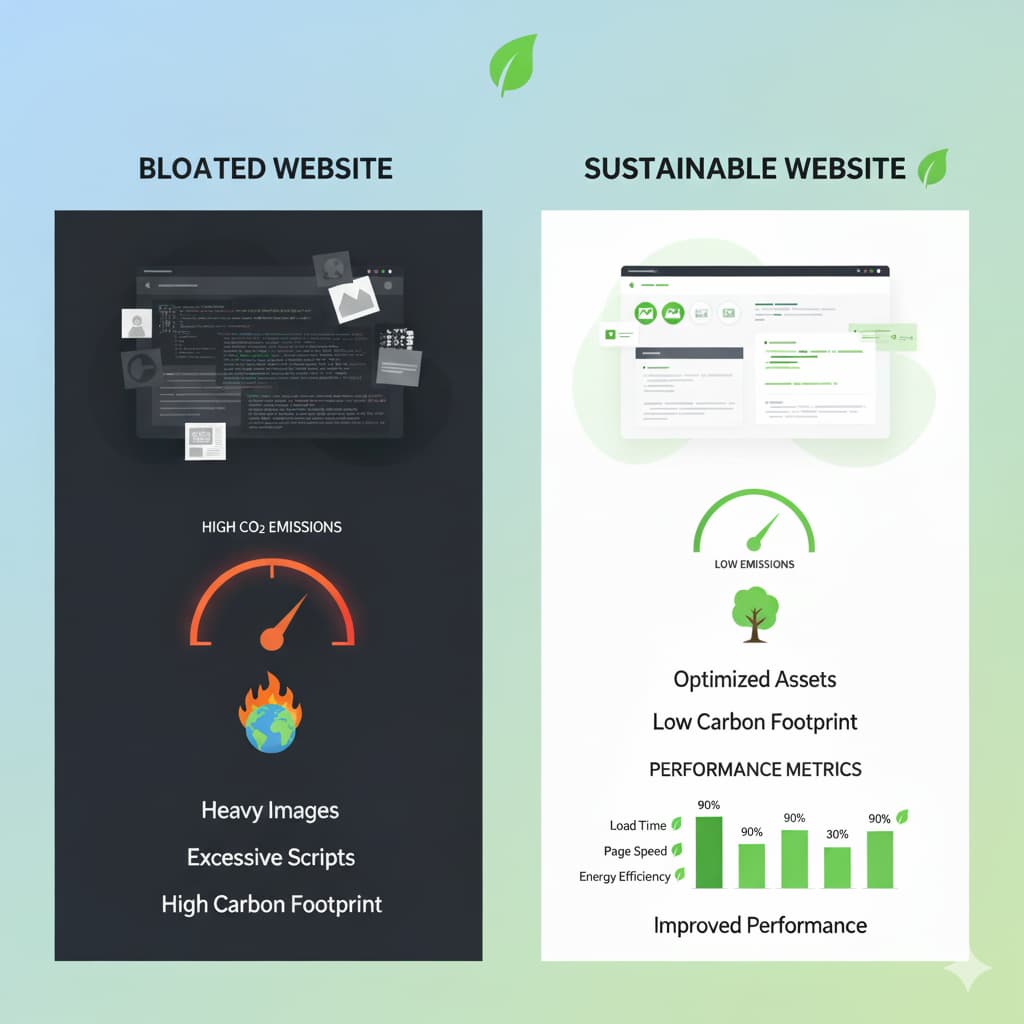
In 2025, sustainable web design has evolved beyond buzzword into business practice—and it perfectly aligns with performance optimization. The web’s carbon footprint now rivals the aviation industry, and efficient websites reduce environmental impact while improving user experience and cutting costs.
The connection: Every performance improvement reduces energy consumption. Faster sites use less processing power, transfer less data, and require fewer server resources.
Why Sustainable Web Design Matters for San Diego
San Diego leads California in environmental consciousness, with businesses increasingly expected to demonstrate sustainability commitments. Your website’s carbon footprint matters to eco-conscious consumers—and the correlation between fast, sustainable sites and business success is undeniable.
The business case:
- Lower hosting costs (efficient sites need less server power)
- Better SEO rankings (Google rewards fast sites)
- Improved conversions (users don’t wait for bloated pages)
- Brand differentiation (sustainability as competitive advantage)
Real San Diego Example: Eco-Conscious Retail
A North Park zero-waste store rebuilt their site with sustainable practices: optimized images, minimal JavaScript, green hosting. Result: 68% faster load times, 45% reduction in hosting costs, and increased engagement from environmentally-minded customers who appreciated the alignment with brand values.
Practical Implementation
Image & Asset Optimization:
- Compress images to WebP format (30-50% smaller than JPEG)
- Lazy load images below the fold
- Use system fonts or carefully chosen web fonts
- Remove unused CSS and JavaScript
Hosting & Infrastructure:
- Choose green hosting providers (powered by renewable energy)
- Implement aggressive caching strategies
- Use CDNs to reduce data transfer distances
- Consider static site generators like Astro or 11ty (minimal server processing)
Content Strategy:
- Write efficient code that does more with less
- Audit and remove unnecessary plugins/features
- Optimize video delivery (lazy loading, appropriate compression)
- Design with “digital sobriety” in mind
Measuring Impact
Tools like Website Carbon Calculator measure your site’s CO2 emissions. The average website produces 1.76g CO2 per page view. Well-optimized sites can achieve 0.1g or less.
The alignment: Everything that makes a site sustainable also makes it faster, cheaper to host, and more conversion-friendly. It’s not sacrifice—it’s smart business.
Learn more: Our Static Web Design service builds inherently sustainable, high-performance sites.
4. Dark Mode: Meeting User Expectations
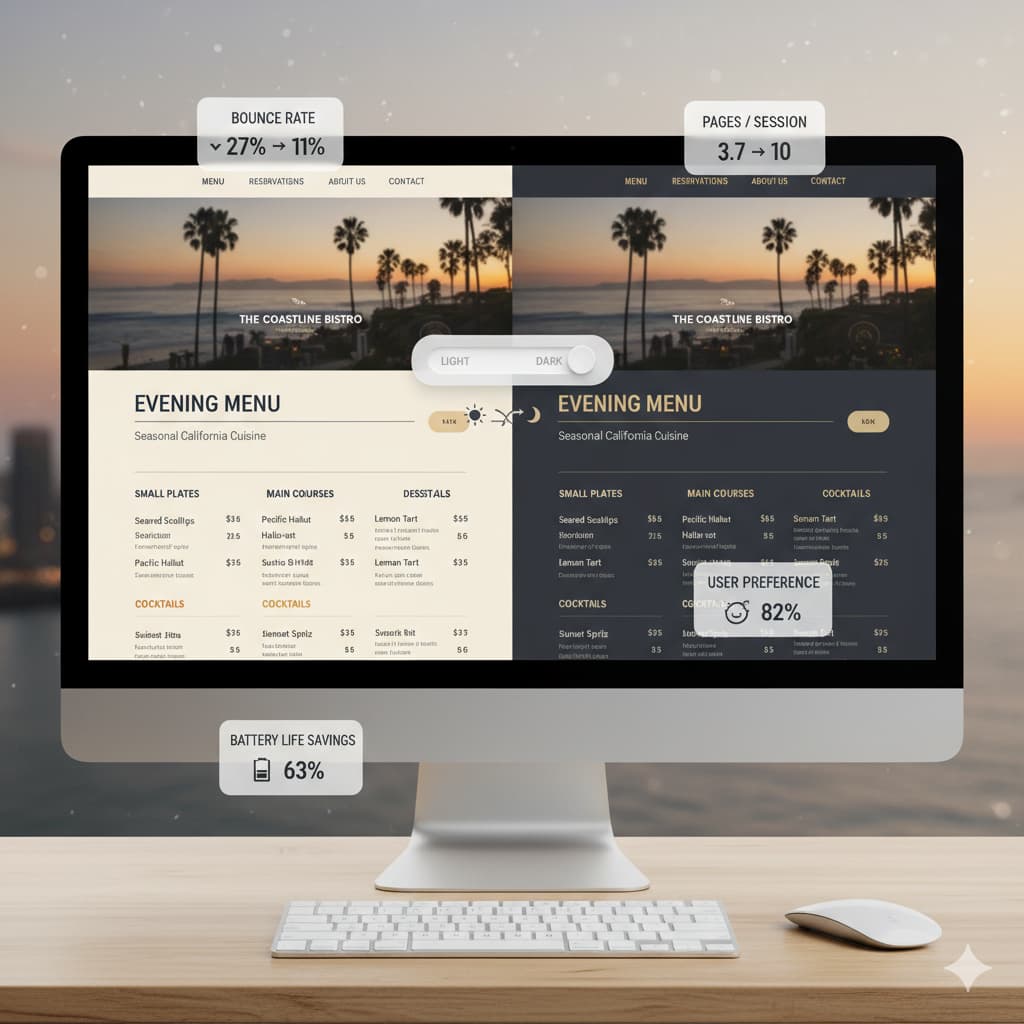
Dark mode has evolved from novelty to expectation. 82% of smartphone users enable dark mode, with 81.9% of Android users and 55-70% of iOS users making it their default.
The engagement benefit: One study showed bounce rates dropping from 27% to 11% after implementing dark mode, while pages per session jumped from 3.7 to 10—a 193% increase.
Why It Matters for San Diego Businesses
- Saves up to 63% battery life (valuable for tourists exploring all day)
- Reduces eye strain for evening browsing (when people research restaurants and nightlife)
- 64.6% want automatic switching based on system preferences
- 59% consider dark mode more modern
Implementation Approach
Don’t simply invert colors—carefully adjust contrast, ensure readability, and maintain brand identity. Test all interactive elements for visibility in both modes.
Important: 42% of users still prefer light mode. Always provide a toggle rather than forcing one option. The best implementation detects system preferences automatically but allows manual override.
5. Strategic Micro-Animations: Motion With Purpose

Subtle motion transforms static websites into responsive experiences. Micro-animations—small, purposeful movements triggered by user actions—provide instant feedback that makes websites feel more intuitive.
When executed well: They increase engagement and guide users through desired actions without adding cognitive load.
Effective Micro-Animations Serve Specific Purposes
- Button hover states confirm clickability
- Loading animations reduce perceived wait time
- Scroll-triggered reveals direct attention to important content
Real San Diego Example: Retail Shop
A Little Italy boutique added subtle product zoom on hover and smooth cart animations. The perceived professionalism increased time on site by 38%, and abandoned carts decreased by 23%.
Best Practices
- Complete animations in 300-500 milliseconds
- Respect the
prefers-reduced-motionsetting (35% of users enable this) - Use CSS transforms to avoid layout shifts that harm Core Web Vitals
- Keep file sizes minimal—animations shouldn’t slow performance
The goal is perceived performance improvement—users should feel the site is faster and more responsive because of animations, not despite them.
Explore: Our Performance Optimization service includes strategic animation implementation.
6. Bold Minimalism: Standing Out While Staying Functional
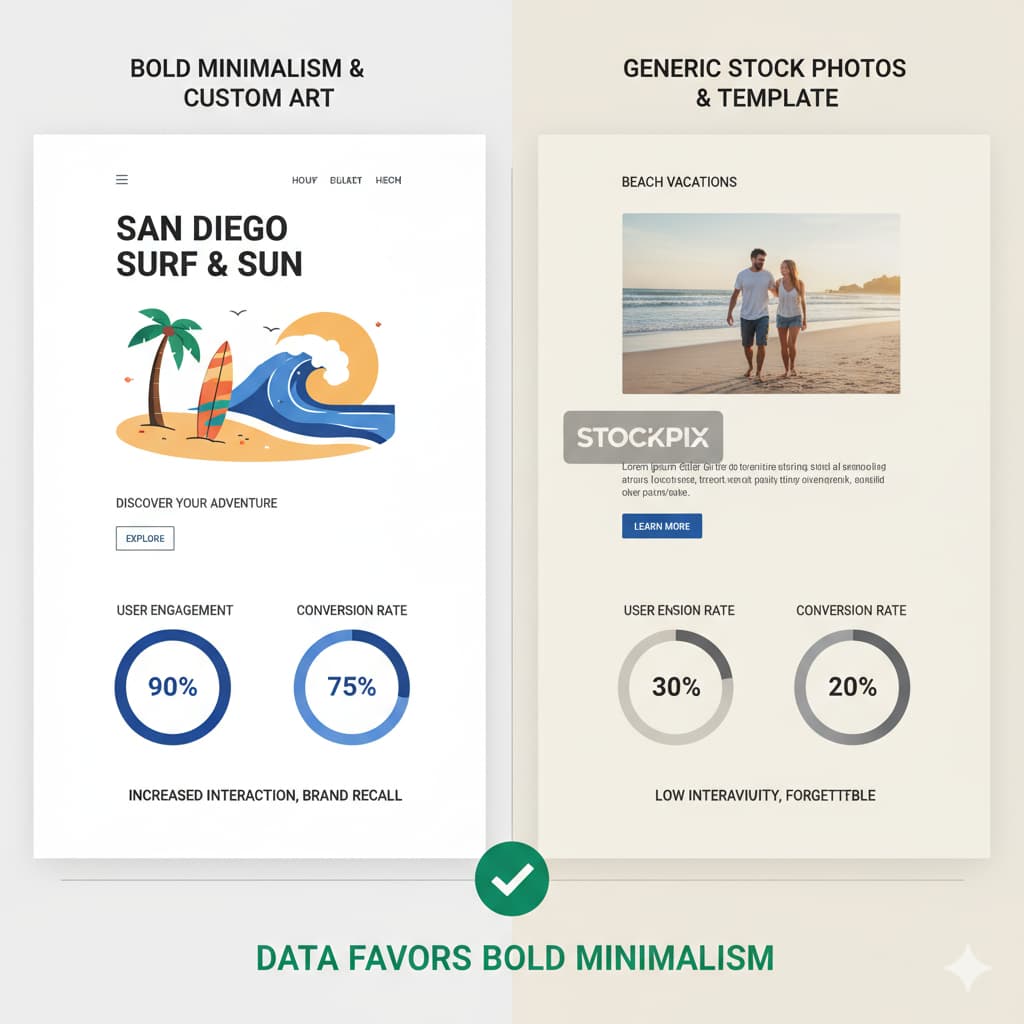
The minimalism versus maximalism debate has resolved into “bold minimalism”—clean layouts with striking visual elements.
The data: 84.6% of users prefer minimalism functionally, but 2025 marks a “bold departure toward self-expression” with 61.5% of sites using decorative, bold fonts as focal elements.
How This Works in Practice
For professional services: Downtown law firms use clean layouts with bold, confident typography that communicates authority while maintaining fast load times.
For lifestyle businesses: Pacific Beach restaurants embrace vivid colors and custom illustrations while maintaining functional clarity.
For tech companies: Sorrento Valley startups balance scientific credibility (clean design) with distinctive visual identity (custom illustrations, bold accents).
Custom Illustrations as Differentiators
40% of business websites now feature custom artwork rather than stock photography. San Diego agencies create illustrations reflecting local context—beaches, sunshine, diverse communities—that generic photos cannot capture.
Performance consideration: Vector illustrations (SVG format) are incredibly lightweight compared to photos, aligning perfectly with speed and sustainability goals.
7. AI-Powered Personalization: The Emerging Edge
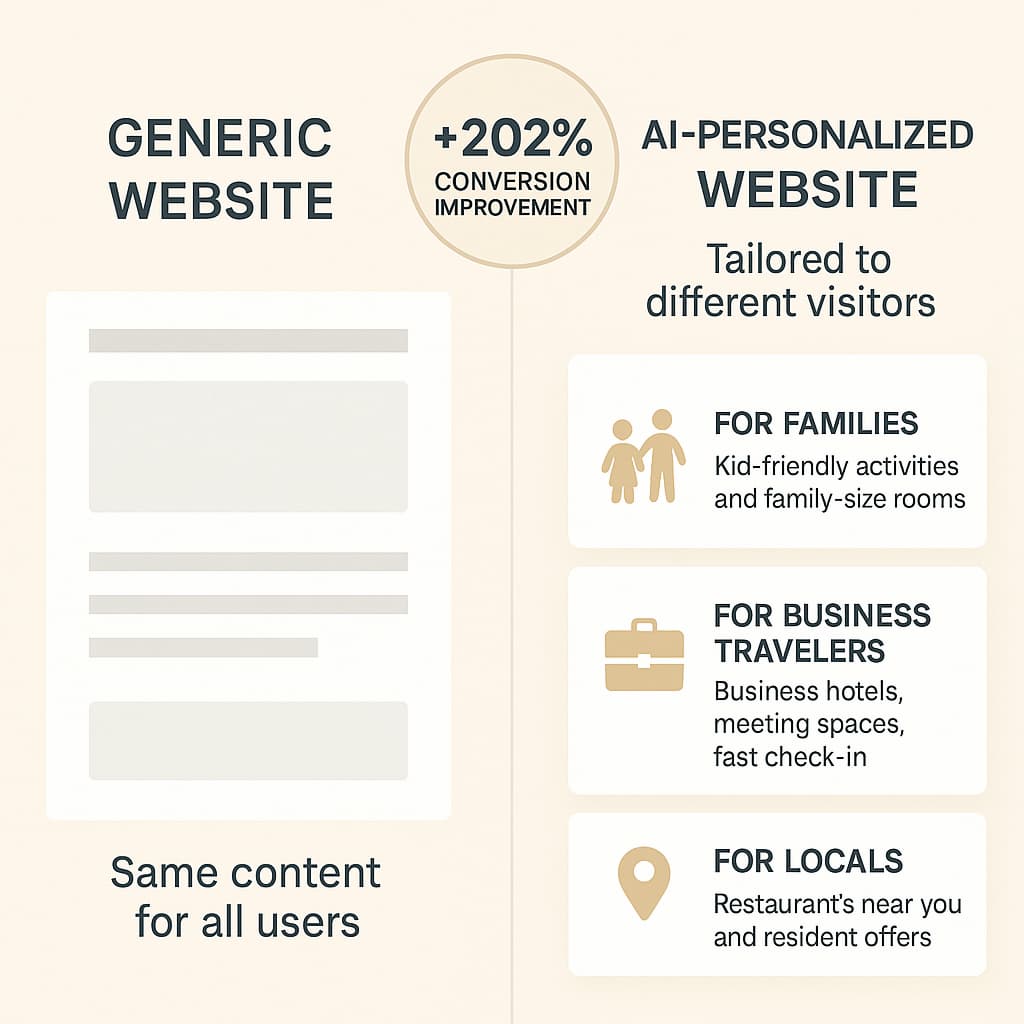
Artificial intelligence represents an emerging opportunity for businesses ready to invest in advanced features. 93% of web designers now use AI tools, and companies excelling at AI-driven personalization generate 40% more revenue than competitors.
Why it matters: 80% of consumers are more likely to buy from companies providing personalized experiences. When 71% expect personalized interactions, AI offers a differentiator for competitive markets.
Real San Diego Example: Local Fitness Studio
A North Park yoga studio implemented an AI chatbot that asks new visitors about their experience level and goals. The bot then recommends appropriate classes and instructors—automatically. Result: 45% increase in first-time bookings and better class fit for new students.
Getting Started
Tools like HubSpot’s AI chatbots start around $50 monthly. Here’s how to approach implementation:
- Start with a chatbot for common questions (hours, services, pricing)
- Gradually expand to behavioral personalization as you collect data
- Be transparent about data collection—only 37% of users trust companies with personal data
The Reality Check
AI personalization delivers impressive results but requires:
- Ongoing investment (tools, data management, refinement)
- Sufficient traffic to collect meaningful behavioral data
- Technical expertise for proper implementation
- Privacy-conscious approach aligned with California regulations
For many San Diego SMBs, focusing on fundamental performance and accessibility delivers better ROI than advanced AI features. Consider AI personalization after mastering core optimizations.
Prioritizing Trends: A Strategic Framework for San Diego Businesses
The real question isn’t which trends to adopt—it’s which to prioritize given your budget and timeline.
Immediate Priorities (All Businesses)
Mobile-first performance and basic accessibility are table stakes. With 60% of web traffic from mobile and 94.8% of websites failing accessibility, budget 40% of your investment toward these fundamentals.
Why these matter most: They directly impact whether visitors can use your site at all. A beautiful design means nothing if it loads too slowly or excludes potential customers.
High-ROI Trends by Industry
Restaurants/Retail: Performance optimization, dark mode for evening browsing, sustainable practices (aligns with eco-conscious consumers)
Real Estate: Mobile performance, accessibility compliance, professional minimalist design
Professional Services: Accessibility (demonstrates inclusivity), bold minimalism (credibility signals), sustainable web practices
Tourism/Hospitality: Mobile-first everything, dark mode, performance optimization, accessibility
Recommended Budget Allocation
For a typical San Diego small business redesign:
- 40% Performance and accessibility fundamentals
- 35% Strategic differentiators (sustainable practices, dark mode, custom design, micro-animations)
- 25% Advanced features (AI personalization if appropriate)
Timeline Considerations
Here’s how to approach phased implementation:
Phase 1 (6-8 weeks): Launch core improvements—performance optimization, mobile responsiveness, accessibility compliance, sustainable hosting
Phase 2 (8-12 weeks): Add strategic features—dark mode, micro-animations, custom illustrations, bold minimalism refinements
Phase 3 (Optional): Advanced capabilities—AI personalization if traffic and budget support it
This delivers immediate value while managing costs and ensuring quality.
The San Diego Advantage
San Diego’s competitive pressure creates better websites industry-wide. With 32 million tourists researching online, hundreds of real estate agencies competing digitally, and 1,467 startups vying for attention, businesses that invest strategically in modern web design position themselves to compete locally and nationally.
What Makes San Diego’s Market Unique
- Tourism: 32 million visitors generating $14.6 billion require mobile-first, fast-loading sites
- Biotech: World’s third-largest hub demands credibility and investor-ready polish
- Environmental consciousness: California leads in sustainability expectations—your website should reflect that
- Local SMBs: From North Park cafes to Hillcrest studios, neighborhood competition is fierce
- Tech-savvy population: Qualcomm, UC San Diego, and 2,000+ tech companies set high expectations
Your Next Steps
The future of San Diego web design trends isn’t about following everything—it’s about strategic choices that serve your business goals and user needs.
Start here:
- Run a performance audit using PageSpeed Insights
- Check accessibility with WAVE
- Measure your carbon footprint at Website Carbon Calculator
- Prioritize based on your industry using the framework above
- Implement in phases rather than attempting everything simultaneously
Ready to Transform Your Website?
At Kalyxo Web, we specialize in performance-first websites that combine modern design with measurable results. Based in San Diego with 12+ years of expertise, we understand what local businesses need to compete—and we build with sustainability and accessibility at the core.
Our approach:
- Speed-obsessed: Every site achieves 90+ Core Web Vitals scores
- Sustainability-focused: Efficient code, green hosting, minimal carbon footprint
- Accessibility expert: WCAG compliant, reaching wider audiences
- Conversion focused: Qualified leads that actually convert
Real results from San Diego businesses:
- 765% organic traffic growth
- 68% reduction in hosting costs through efficiency
- 234% increase in new users
- 60% engagement boost through UX optimization
Get your free website audit to see how we can help your business thrive online with San Diego web design that’s fast, accessible, and sustainable.
Related resources:
- 6 Essential Features for Small Business Websites
- Best San Diego Web Design Companies for 2025
- Static Web Design: Fast, Secure, and SEO-Optimized
FAQs
What web design trends actually improve conversions for San Diego businesses?
Performance optimization prevents 60% of users from abandoning slow sites—every one-second improvement reduces bounce rates 7%. Accessibility improvements can boost conversions up to 400%. Dark mode can increase engagement by 193%. Focus on trends that remove friction or increase usability.
How much does implementing modern web design trends cost in San Diego?
Small business websites with modern features cost $5,000-$15,000. Mid-size businesses range $15,000-$35,000. Many San Diego agencies offer phased approaches spreading costs across 6-12 months with immediate improvements.
Do I need to follow every trend or just focus on fundamentals?
Start with fundamentals (mobile optimization, performance, basic accessibility), then selectively adopt trends that differentiate within your market. A restaurant needs speed and local SEO over complex features; a professional service needs credibility signals and accessibility.
How does sustainable web design benefit my business?
Sustainable web design reduces your carbon footprint while improving performance, lowering hosting costs, and enhancing user experience. Fast, efficient websites rank better in search engines and convert more visitors—sustainability and profitability align perfectly.
Which trends matter most for San Diego's tourism industry?
Tourism businesses see immediate ROI from mobile-first performance (tourists searching while walking), dark mode for evening browsing, and accessibility compliance. With 32 million annual visitors generating $14.6 billion, these trends directly impact bookings.
Is website accessibility legally required in California?
Yes. California led the nation with 3,252 ADA website lawsuits in 2024—a 37% jump from 2023. Beyond legal risk, accessible websites show measurably higher revenue and can boost conversions up to 400%.
